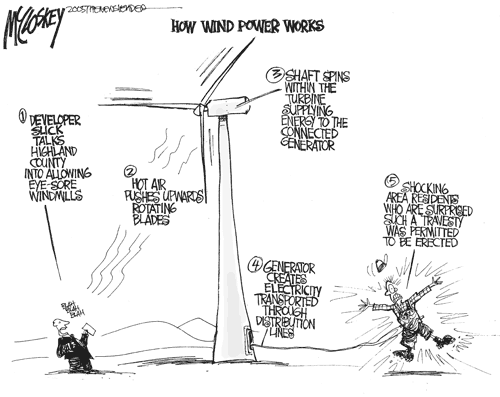Wind power is an incredibly clean renewable power source. To capture the energy in wind, wind farms are used. So, how about wind farm efficiency?
Wind Farm Efficiency
Wind power is the process by which wind is used to generate power or electricity. The power of the wind is actually a form of solar power – wind change and variability is caused by uneven heating of the ground by the sun. In order to fully use the power that the wind is capable of generating, many countries have set up wind farms. In a wind farm, many different wind turbines (a structure that uses a propeller-like blade to take in the wind's power) are set up in an area. With all the wind turbines working at the same time, it's thought that these farms are a great way to produce large amounts of electricity.
 To determine the efficiency of wind farms, you need to know how a wind farm works. The wind turbines collect the power of the wind in two steps: the propeller blades are turned by the gusts of wind, and the propeller then turns a shaft. This turning shaft is connected to a generator. The spinning action cranks the generator, which then produces electricity. The process is exactly like hydropower, but with wind acting as the energy source instead of flowing water. Just one wind turbine set up in an area will not produce very much electricity, and is not very good for powering large areas - these small turbines are usually used to power just one farm or house or occasionally to pump water.
To determine the efficiency of wind farms, you need to know how a wind farm works. The wind turbines collect the power of the wind in two steps: the propeller blades are turned by the gusts of wind, and the propeller then turns a shaft. This turning shaft is connected to a generator. The spinning action cranks the generator, which then produces electricity. The process is exactly like hydropower, but with wind acting as the energy source instead of flowing water. Just one wind turbine set up in an area will not produce very much electricity, and is not very good for powering large areas - these small turbines are usually used to power just one farm or house or occasionally to pump water.
Wind farms, on the other hand, are more powerful because there is a large grouping of the wind turbines in one area, all working in unison to produce electricity. The energy can then be run to whole communities through existing utility grids or stored in battery-like storage cells. Wind turbines can be set up to face the wind or face away from the wind. Modern wind turbines can also turn to catch the wind as it gusts from different angles, a factor which makes them far more efficient than before. The larger the turbine's blades and the taller the turbine's height will increase the efficiency as well.
The exact efficiency of wind farms is nearly impossible to pinpoint. The problem is found in the factors that go into the analysis. The terrain, amount of wind, size of turbines and so on varies from wind farm to farm. There is no constant, which makes it difficult to nail down general efficiency ratings. In general, a single wind turbine will convert about 20 percent of the energy in wind to electricity. The most efficient production occurs between five and 20 miles an hour of wind speed. This general 20 percent efficiency rating is roughly seven to five percent more efficient than solar power, but sunlight is constant whereas wind is not.
While wind technology has not yet progressed to a point where no energy is lost while harnessing it, it is fair to say that the platform is favorable compared to other renewable sources. It may take a while for the whole world to catch on to using the power of the wind, but it's definitely fast becoming an important alternative energy source. Countries such as Germany are certainly investing a lot into the platform.
Rick Chapo is with SolarCompanies.com. Visit us for more wind farm articles.




